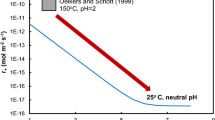Abstract
A kinetic model for the dissolution of borosilicate glass, incorporated into the EQ3/6 geochemical modeling code, is used to predict the dissolution rate of a nuclear waste glass. In the model, the glass dissolution rate is controlled by the rate of dissolution of an alkali-depleted amorphous surface (gel) layer. Assuming that the gel layer dissolution affinity controls glass dissolution rates is similar to the silica saturation concept of Grambow [1] except that our model predicts that all components concentrated in the surface layer, not just silica, affect glass dissolution rates. The good agreement between predicted and observed elemental dissolution rates suggests that the dissolution rate of the gel layer limits the overall rate of glass dissolution. The model predicts that the long-term rate of glass dissolution will depend mainly on ion concentrations in solution, and therefore on the secondary phases which precipitate and control ion concentrations.
Work performed under the auspices of the U. S. Department of Energy by the Lawrence Livermore National Laboratory under contract no. W-7405-ENG-48.
Similar content being viewed by others
References
Grambow, Bernd (1987) SKB JSS Project. Report 87-02. 112 pages.
Abrajano, T. A., and J. K. Bates (1987) Sci. Basis for Nucl. Waste Met., X. J. K. Bates and W. B. Seefeldt (Eds.), Mat. Res. Soc., 84:533–546.
Phinney, D. L., F. J. Ryerson, V. M. Oversby, W. A. Lanford, R. D. Aines, and J. K. Bates (1986) Sci. Basis for Nucl. Waste Met., X, J. K. Bates and W. B. Seefeldt (Eds.), Mat. Res. Soc., 84:433–446.
Dorhemus, R. H. (1983) J. Non-Crystal. Solids, 55:143–147.
Lasaga (1984) J. Geophysical Res., 89:4009–4025.
Stumm, Werner, and James Morgan (1981) Aquatic Chemistry John Wiley and Sons, 780 p.
Wolery, T. J. (1979) Lawrence Livermore National Laboratory UCRL-52658, 41 p.
Savage, D. (1986) Nuclear and Chem. Waste Management, 6:15–39.
Bunker, B. C., D. R. Tallant, T. J. Headley, G. L. Turner, and R. J. Kirkpatrick (1988) Phy. Chem. Glasses, 29:106–120.
Stumm, W. and Furrer (1988) Aquatic Surface Chemistry, W. Stumm, [Ed.] John Wiley and Sons, 112:663–672.
Author information
Authors and Affiliations
Rights and permissions
About this article
Cite this article
Bourcier, W.L., Peiffer, D.W., Knauss, K.G. et al. A Kinetic Model for Borosilicate Glass Dissolution Based on the Dissolution Affinity of a Surface Alteration Layer. MRS Online Proceedings Library 176, 209 (1989). https://doi.org/10.1557/PROC-176-209
Published:
DOI: https://doi.org/10.1557/PROC-176-209




